February 6, 2024
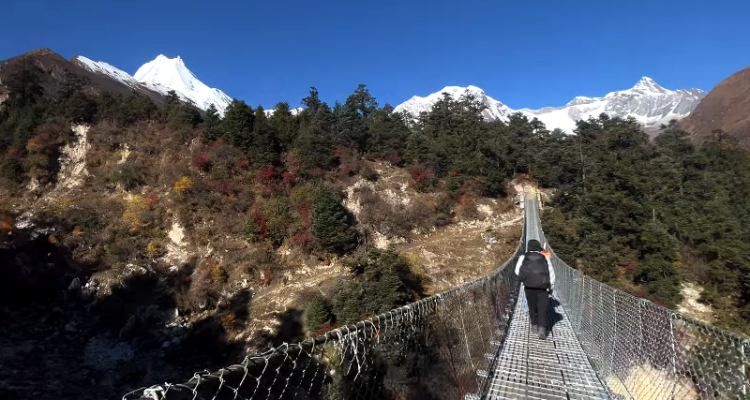
The Manaslu Circuit Trek presents an enchanting journey through the heart of the Nepalese Himalayas, offering adventurers a blend of cultural immersion, rugged terrain, and breathtaking scenery. Named after the eighth highest peak in the world, Mount Manaslu, this trek stands as a testament to the raw beauty and serenity of the remote regions of Nepal.
Embarking on the Manaslu Circuit Trek is like stepping into a world untouched by time. Unlike the bustling trails of Everest or Annapurna, this route remains relatively less traveled, granting trekkers a sense of solitude and immersion in the pristine wilderness. As you traverse through remote villages nestled amidst towering peaks, you’ll encounter the traditional Tibetan culture that permeates every aspect of life in this region.
The diversity of landscapes encountered along the trek is truly remarkable. From verdant valleys adorned with terraced fields to rugged mountain passes draped in prayer flags, each step unveils a new facet of nature’s grandeur. Meandering alongside roaring rivers and through dense forests of rhododendron and pine, the trail leads you towards high-altitude vistas that will leave you breathless.
Central to the Manaslu Circuit Trek is the opportunity for cultural exploration. Buddhist monasteries, intricately carved mani walls, and prayer wheels dot the landscape, offering glimpses into the spiritual traditions of the local inhabitants. Interactions with villagers provide insight into their daily lives, as you share in their hospitality and learn about their customs passed down through generations.
However, the trek is not without its challenges. As you ascend to higher elevations, the thin air and steep terrain demand physical endurance and acclimatization. Crossing formidable mountain passes like the Larkya La Pass at 5,160 meters presents both a test of strength and an opportunity for unparalleled views of the surrounding Himalayan peaks.
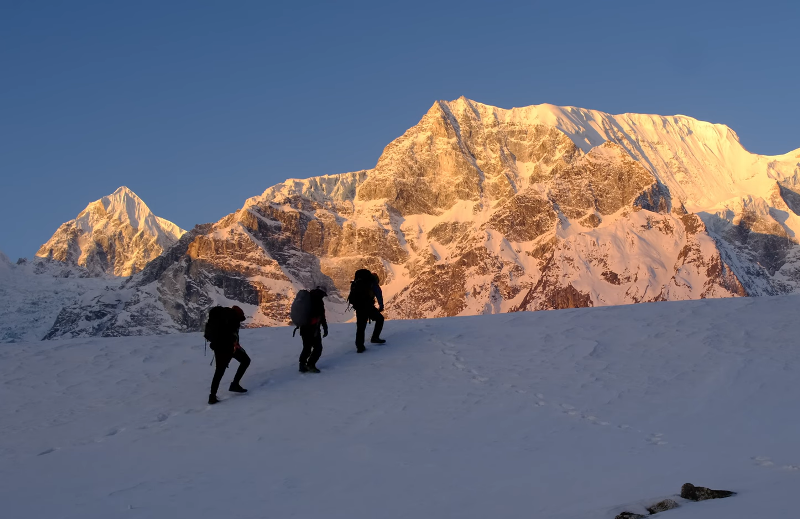
Snow covered hill near Larke Pass
Throughout the journey, the allure of the Himalayas is ever-present, with snow-capped summits like Manaslu, Ganesh Himal, and Himlung Himal dominating the horizon. Wildlife sightings, from the elusive snow leopard to herds of blue sheep, add an element of excitement to the trek, reminding trekkers of the rich biodiversity that thrives in these rugged landscapes.
In conclusion, the Manaslu Circuit Trek offers an unforgettable adventure for those seeking a harmonious blend of natural beauty, cultural richness, and physical challenge. As you tread lightly upon ancient trails and bask in the magnificence of the Himalayas, the memories forged along this journey will linger long after you’ve returned home.
Day 1: Kathmandu to Maccha Khola (Drive)
Altitude: Kathmandu (1,400m) to Maccha Khola (930m)
Your journey begins with a picturesque drive from Kathmandu to Maccha Khola, a charming village nestled along the banks of the Budi Gandaki River. Marvel at the changing landscapes as you descend from the bustling capital into the tranquil countryside. Upon reaching Maccha Khola, settle into a cozy Tea House and prepare for the adventures ahead.
Day 2: Maccha Khola to Jagat
Altitude: Maccha Khola (930m) to Jagat (1,410m)
Embark on a trek filled with natural wonders and cultural encounters as you traverse the rugged terrain of the Manaslu region. Follow the meandering path alongside the Budi Gandaki River, passing through lush forests and picturesque Gurung villages. En route, immerse yourself in the local culture and marvel at the traditional architecture that dots the landscape. Conclude your day in Jagat, a quaint village adorned with stone houses and terraced fields.
Day 3: Jagat to Deng
Altitude: Jagat (1,410m) to Deng (1,800m)
Continue your trek through enchanting landscapes, ascending gently towards the village of Deng. Traverse dense forests and tranquil streams, encountering colorful prayer flags and ancient monasteries along the way. Take in the breathtaking vistas of snow-capped peaks as you make your way to Deng, where you’ll spend the night amidst the serene beauty of the Himalayas.
Day 4: Deng to Namrung
Altitude: Deng (1,800m) to Namrung (2,630m)
Embark on a scenic journey through the heart of the Manaslu region, ascending steadily towards Namrung. Trek through lush bamboo forests and quaint mountain villages, pausing to admire the towering peaks that loom overhead. As you ascend to higher altitudes, take time to acclimatize and soak in the majestic beauty of your surroundings. Arrive in Namrung, a picturesque village nestled amidst the snow-capped peaks, and unwind in the comfort of a cozy Tea House.
Day 5: Namrung to Lho
Altitude: Namrung (2,630m) to Lho (3,180m)
Set out on a captivating journey through the heart of the Nubri Valley, trekking past terraced fields and traditional Tibetan villages. Marvel at the intricate stone carvings and ancient monasteries that line the trail, immersing yourself in the rich cultural heritage of the region. As you ascend to higher altitudes, take time to acclimatize and enjoy panoramic views of the surrounding Himalayas. Arrive in Lho, a charming village renowned for its stunning views of Manaslu and its neighboring peaks.
Day 6: Lho to Sama Gaun
Altitude: Lho (3,180m) to Sama Gaun (3,530m)
Embark on a leisurely trek through the picturesque landscapes of the Manaslu region, ascending gently towards Sama Gaun. Trek past lush pine forests and tranquil streams, pausing to admire the vibrant prayer flags that flutter in the breeze. As you approach Sama Gaun, marvel at the towering peaks that dominate the skyline, including the majestic Manaslu. Arrive in Sama Gaun and immerse yourself in the rich cultural heritage of the region, exploring the charming village and its surrounding countryside.
Day 7: Acclimatization Day (Day Trip to Manaslu Base Camp or Pungyen Gompa)
Take a well-deserved break from trekking and embark on an exhilarating day trip to either Manaslu Base Camp or Pungyen Gompa. Marvel at the breathtaking vistas of the surrounding Himalayas as you trek through pristine alpine landscapes. Take time to acclimatize to the higher altitudes and soak in the serene beauty of your surroundings. Return to Sama Gaun in the evening and unwind amidst the tranquil ambiance of the Himalayas.
Day 8: Sama Gaun to Samdo
Altitude: Sama Gaun (3,530m) to Samdo (3,690m)
Resume your trek through the rugged terrain of the Manaslu region, ascending steadily towards the village of Samdo. Trek past expansive yak pastures and ancient monasteries, pausing to admire the panoramic views of the surrounding Himalayas. As you approach Samdo, marvel at the towering peaks that dominate the skyline, including the majestic Manaslu. Arrive in Samdo and unwind amidst the serene beauty of the Himalayas, exploring the charming village and its surrounding countryside.
Day 9: Acclimatization Day (Day Trip to Tibet Border)
Take a break from trekking and embark on an exhilarating day trip to the Tibetan border. Marvel at the breathtaking vistas of the surrounding Himalayas as you trek through pristine alpine landscapes. Take time to acclimatize to the higher altitudes and soak in the serene beauty of your surroundings. Return to Samdo in the evening and unwind amidst the tranquil ambiance of the Himalayas.
Day 10: Samdo to Dharmasala
Altitude: Samdo (3,690m) to Dharmasala (4,480m)
Resume your trek through the rugged terrain of the Manaslu region, ascending steadily towards Dharmasala. Trek past pristine alpine meadows and glacial lakes, pausing to admire the breathtaking vistas of the surrounding Himalayas. As you approach Dharmasala, marvel at the towering peaks that dominate the skyline, including the majestic Manaslu. Arrive in Dharmasala and unwind amidst the serene beauty of the Himalayas, preparing for the challenging ascent to Larkya La Pass.
Day 11: Dharmasala to Bimthang via Larkya Pass
Altitude: Dharmasala (4,480m) – Larkya La Pass (5,160m) – Bimthang (3,720m)
Embark on an exhilarating ascent to Larkya La Pass, the highest point of your trek. Trek through rugged terrain and pristine alpine landscapes, pausing to admire the panoramic views of the surrounding Himalayas. As you approach Larkya La Pass, take time to acclimatize to the higher altitudes and soak in the serene beauty of your surroundings. Arrive at Larkya La Pass and marvel at the breathtaking vistas of snow-capped peaks before descending to Bimthang for a well-deserved rest.
Day 12: Bimthang to Dharapani
Altitude: Bimthang (3,720m) to Dharapani (1,960m)
Descend from the high-altitude landscapes of the Manaslu region, trekking through lush forests and tranquil villages. Enjoy the scenic beauty of the surrounding countryside as you make your way towards Dharapani. Pause to admire the cascading waterfalls and vibrant flora that line the trail, immersing yourself in the natural splendor of the Himalayas. Arrive in Dharapani and take a moment to reflect on the incredible journey you’ve undertaken through the Manaslu region. As you descend to lower altitudes, notice the changes in vegetation and climate, providing a stark contrast to the rugged landscapes of the high Himalayas. Arrive in Dharapani, a bustling village nestled amidst terraced fields and quaint stone houses, and unwind in the comfort of a cozy Tea House.
Day 13: Dharapani to Kathmandu
Altitude: Dharapani (1,960m) to Kathmandu (1,400m)
Bid farewell to the serene beauty of the Himalayas as you embark on the final leg of your journey back to Kathmandu. Traverse winding mountain roads and lush valleys, soaking in the last glimpses of the majestic peaks that tower overhead. Arrive in Kathmandu, where your adventure began, and take a moment to reflect on the memories forged during your trek through the Manaslu region. Unwind in the comfort of your hotel, surrounded by the bustling energy of Nepal’s vibrant capital city.
With each day offering unique experiences and breathtaking vistas, this detailed itinerary ensures you make the most of your Manaslu Circuit trek, immersing yourself in the natural beauty and rich cultural heritage of the Himalayas. Embark on this unforgettable journey and create memories that will last a lifetime.
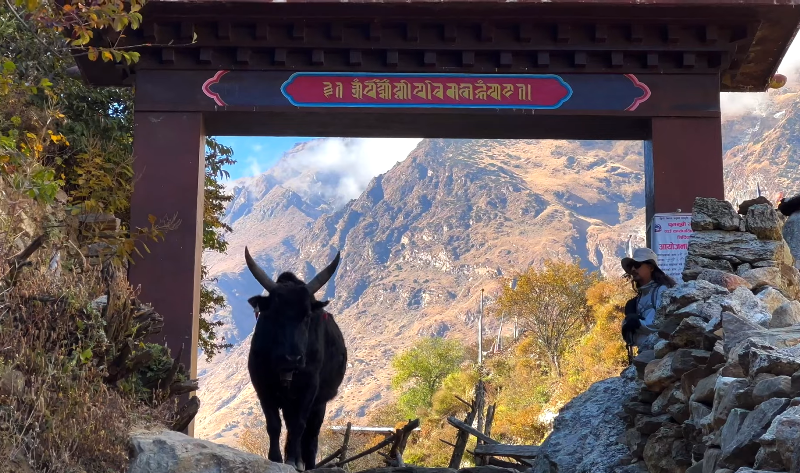
The Manaslu Trek, situated in Nepal, offers a challenging yet rewarding journey around the world’s eighth highest mountain. With stunning vistas and cultural encounters, it’s a popular choice for adventurous trekkers.
Here are Four outline itineraries for the Manaslu Circuit Trek, each with different durations and altitudes:
DAY 01: Kathmandu to Soti Khola (Drive) – Altitude: Kathmandu (1,400m) to Soti Khola (700m)
DAY 02: Soti Khola to Machha Khola – Altitude: 700m to 900m
DAY 03: Machha Khola to Jagat – Altitude: 900m to 1,400m
DAY 04: Jagat to Deng – Altitude: 1,400m to 1,800m
DAY 05: Deng to Namrung – Altitude: 1,800m to 2,630m
DAY 06: Namrung to Samagaon – Altitude: 2,630m to 3,530m
DAY 07: Acclimatization Day at Samagaon (Side trip to Manaslu Base Camp) – Altitude: 3,530m
DAY 08: Samagaon to Samdo – Altitude: 3,530m to 3,860m
DAY 09: Samdo to Dharamsala – Altitude: 3,860m to 4,480m
DAY 10: Dharamsala to Bimthang via Larkya Pass – Altitude: 4,480m (Larkya Pass) to 3,720m
DAY 11: Bimthang to Tilije – Altitude: 3,720m to 2,300m
DAY 12: Tilije to Tal – Altitude: 2,300m to 1,700m
DAY 13: Tal to Syange – Altitude: 1,700m to 1,100m
DAY 14: Syange to Kathmandu (Drive) – Altitude: 1,100m to 1,400m

DAY 01: Kathmandu to Soti Khola (Drive) – Altitude: Kathmandu (1,400m) to Soti Khola (700m)
DAY 02: Soti Khola to Machha Khola – Altitude: 700m to 900m
DAY 03: Machha Khola to Jagat – Altitude: 900m to 1,400m
DAY 04: Jagat to Deng – Altitude: 1,400m to 1,800m
DAY 05: Deng to Namrung – Altitude: 1,800m to 2,630m
DAY 06: Namrung to Lho – Altitude: 2,630m to 3,180m
DAY 07: Lho to Samagaon – Altitude: 3,180m to 3,530m
DAY 08: Acclimatization Day at Samagaon (Side trip to Manaslu Base Camp) – Altitude: 3,530m
DAY 09: Samagaon to Samdo – Altitude: 3,530m to 3,860m
DAY 10: Samdo to Dharamsala – Altitude: 3,860m to 4,480m
DAY 11: Dharamsala to Bimthang via Larkya Pass – Altitude: 4,480m (Larkya Pass) to 3,720m
DAY 12: Bimthang to Tilije – Altitude: 3,720m to 2,300m
DAY 13: Tilije to Chamje – Altitude: 2,300m to 1,410m
DAY 14: Chamje to Bulbule – Altitude: 1,410m to 840m
DAY 15: Bulbule to Besisahar (Drive) – Altitude: 840m to 760m
DAY 16: Besisahar to Kathmandu (Drive) – Altitude: 760m to 1,400m
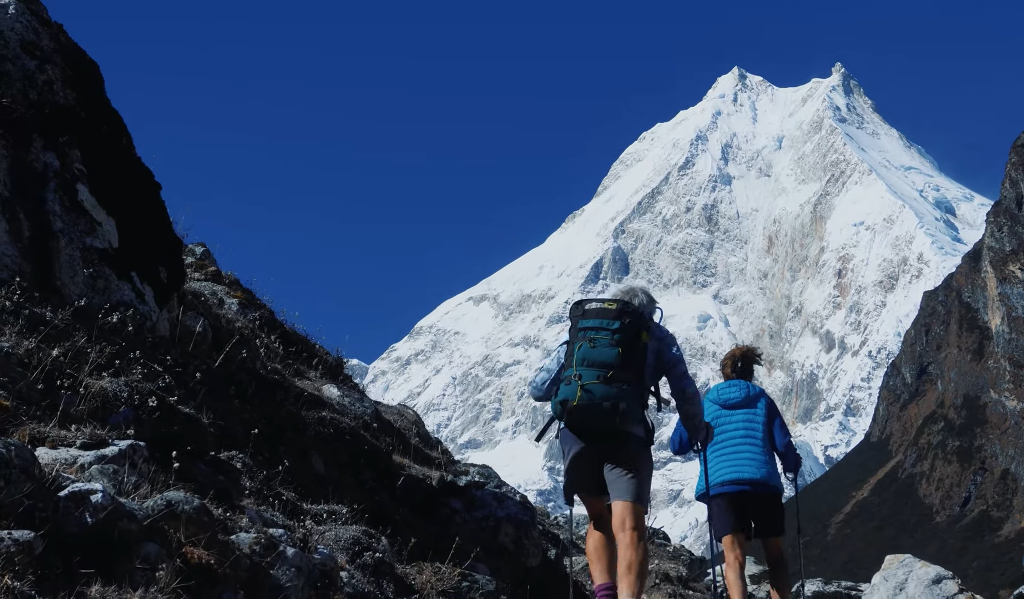
Stunning Manaslu Mountain View
DAY 01: Kathmandu to Soti Khola (Drive) – Altitude: Kathmandu (1,400m) to Soti Khola (700m)
DAY 02: Soti Khola to Machha Khola – Altitude: 700m to 900m
DAY 03: Machha Khola to Jagat – Altitude: 900m to 1,400m
DAY 04: Jagat to Deng – Altitude: 1,400m to 1,800m
DAY 05: Deng to Namrung – Altitude: 1,800m to 2,630m
DAY 06: Namrung to Lho – Altitude: 2,630m to 3,180m
DAY 07: Lho to Samagaon – Altitude: 3,180m to 3,530m
DAY 08: Acclimatization Day at Samagaon (Side trip to Manaslu Base Camp) – Altitude: 3,530m
DAY 09: Samagaon to Samdo – Altitude: 3,530m to 3,860m
DAY 10: Samdo to Dharamsala – Altitude: 3,860m to 4,480m
DAY 11: Dharamsala to Bimthang via Larkya Pass – Altitude: 4,480m (Larkya Pass) to 3,720m
DAY 12: Bimthang to Tilije – Altitude: 3,720m to 2,300m
DAY 13: Tilije to Chamje – Altitude: 2,300m to 1,410m
DAY 14: Chamje to Syange – Altitude: 1,410m to 1,100m
DAY 15: Syange to Tal – Altitude: 1,100m to 1,700m
DAY 16: Tal to Bahundanda – Altitude: 1,700m to 1,310m
DAY 17: Bahundanda to Besisahar – Altitude: 1,310m to 760m
DAY 18: Besisahar to Kathmandu (Drive) – Altitude: 760m to 1,400m
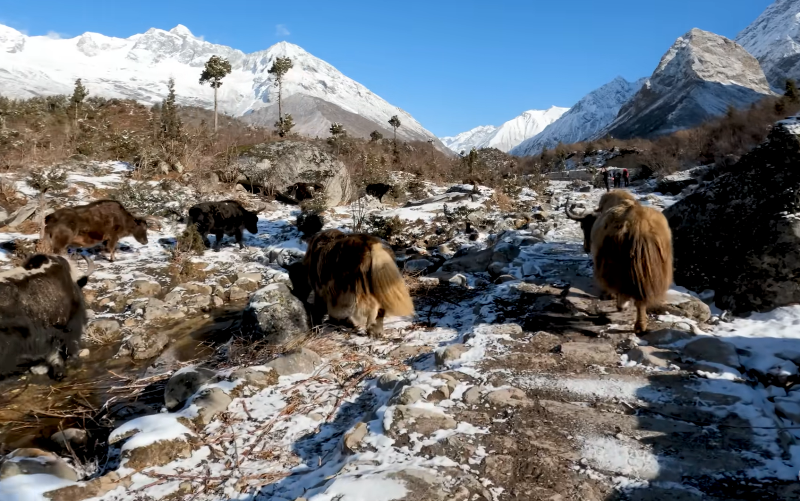
Ways in manslu trails
DAY 01: Kathmandu to Soti Khola (Drive) – Altitude: Kathmandu (1,400m) to Soti Khola (700m)
DAY 02: Soti Khola to Machha Khola – Altitude: 700m to 900m
DAY 03: Machha Khola to Jagat – Altitude: 900m to 1,400m
DAY 04: Jagat to Deng – Altitude: 1,400m to 1,800m
DAY 05: Deng to Namrung – Altitude: 1,800m to 2,630m
DAY 06: Namrung to Samagaon – Altitude: 2,630m to 3,530m
DAY 07: Samagaon to Samdo – Altitude: 3,530m to 3,860m
DAY 08: Samdo to Dharamsala – Altitude: 3,860m to 4,480m
DAY 09: Dharamsala to Bimthang via Larkya Pass – Altitude: 4,480m (Larkya Pass) to 3,720m
Day 10: Bimthang to Dharapani – Altitude: 3,720m to 1,960m, than Drive to Kathmandu by private jeep.
This option provides a condensed but still fulfilling trekking experience of the Manaslu Circuit, covering the key highlights and ascending to Larkya Pass before descending to Dharapani to conclude the trek.
Returning from Dharapani to Kathmandu by jeep after completing the Manaslu trek can indeed be an adventurous option, especially considering the off-road nature of the journey. Here’s a detailed description based on the provided information:
Cost: Renting an entire jeep for the journey from Dharapani to Kathmandu for around $350 USD is a reasonable rate, especially considering the remote and rugged terrain of the Manaslu region. While this may seem expensive compared to other forms of transportation in Nepal, it’s important to factor in the convenience, comfort, and flexibility that a private jeep offers, particularly if traveling in a group.
Time: The journey by jeep from Dharapani to Kathmandu typically takes around 7 to 10 hours, as mentioned earlier. However, due to the off-road conditions and potential obstacles along the route, such as landslides or road repairs, travelers should be prepared for possible delays. It’s advisable to plan for a full day of travel to allow for unexpected circumstances.
Off-road Conditions: The road from Dharapani to Kathmandu is predominantly off-road, meaning it involves driving on unpaved or rough terrain, especially in the mountainous regions. This can include rocky paths, river crossings, steep inclines, and narrow passages. Traveling on such terrain requires a sturdy and capable vehicle like a jeep, which can navigate these challenging conditions more effectively than smaller vehicles.
Vehicle Condition: Renting a jeep for this journey is a practical choice, as jeeps are well-suited for off-road driving and can provide a more comfortable ride compared to other vehicles. However, it’s essential to ensure that the jeep is in good condition, with robust suspension, tires suitable for rough terrain, and a reliable engine. Additionally, having an experienced driver familiar with the route is crucial for a safe and efficient journey.
Overall, while the cost of renting a jeep for the journey from Dharapani to Kathmandu may initially seem high, it offers several advantages, including convenience, comfort, and the ability to navigate challenging off-road terrain. Travelers opting for this option should be prepared for an adventurous journey through the breathtaking landscapes of the Manaslu region, with the assurance of a reliable and capable vehicle to get them safely back to Kathmandu.
Traveling from Dharapani to Besisahar offers two options: a local jeep ride costing between $20 to $25 per person or booking a private jeep for $200 to $230. From Besisahar, you can proceed to Kathmandu either by private jeep or by taking the local bus, with the journey taking an extra 5 to 6 hours.
Manaslu Circuit Trek is one of the most beautiful and adventurous treks in Nepal, offering stunning views of the Himalayas and a unique cultural experience. Here’s a breakdown of the costs and what’s included in a typical Manaslu trek package:
Cost: $790 USD per person.
Meals: Three meals a day are included throughout the trek. These typically consist of traditional Nepali and international dishes served at teahouses along the route.
Accommodation: Accommodation at teahouses along the trekking route is included. Teahouses provide basic lodging with shared facilities, offering a cozy and authentic experience.
Transportation: The package includes transportation from Kathmandu to Soti Khola. This is typically provided by bus, but there’s an option for a private jeep, with additional costs depending on the group size.
Permits: The package includes the special permits required for the Manaslu Circuit Trek, namely the Manaslu Special Permit, Annapurna Conservation Area Permit (ACAP), and Manaslu Conservation Area Permit (MCAP).
Guide: An experienced guide will accompany the trekking group throughout the journey. The guide provides navigation, cultural insights, and ensures safety during the trek.
Porter: There’s a porter included for every two trekkers. The porter assists with carrying luggage, allowing trekkers to enjoy the journey without the burden of heavy loads.
Farewell Dinner: The package often includes a farewell dinner with a Nepali family in Kathmandu, offering a cultural experience and a chance to celebrate the completion of the trek.
Trek Ending Transport: Transportation from the trek ending spot back to Kathmandu is provided as part of the package. This ensures a hassle-free return journey after completing the trek.
Overall, the Manaslu Circuit Trek package offers comprehensive services, ensuring a comfortable and memorable trekking experience in one of Nepal’s most spectacular regions.
For the Manaslu Circuit trek, trekkers need several permits and must comply with specific regulations. The first essential permit is the Manaslu Restricted Area Permit, required for all trekkers, which is obtained through a registered trekking agency. Additionally, a Manaslu Conservation Area Permit (MCAP) is necessary, along with an Annapurna Conservation Area Permit (ACAP), as the trek passes through both conservation areas. Trekkers are also required to be part of a minimum group of two people and must be accompanied by a licensed trekking guide. These regulations aim to ensure safety, minimize environmental impact, and support local communities along the trekking route.
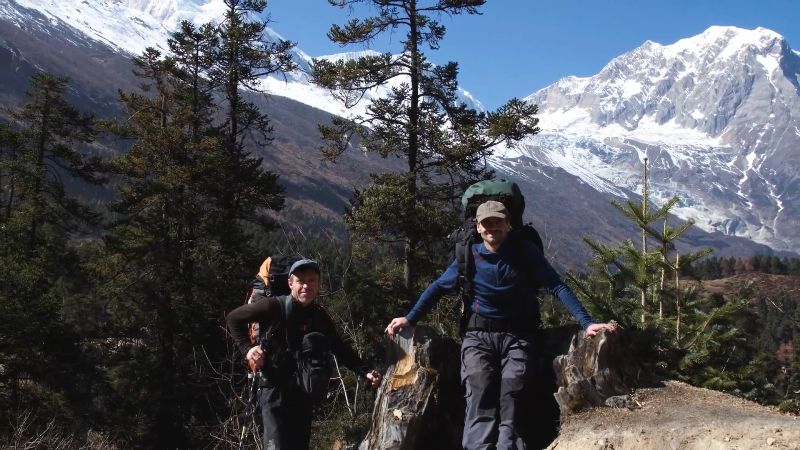
Altitude sickness, or acute mountain sickness (AMS), is a potential concern during high-altitude treks like the Manaslu Circuit. Here are some prevention and management tips:
Gradual ascent: Allow your body time to acclimatize by ascending slowly. Stick to the recommended itinerary and include rest days for acclimatization.
Stay hydrated: Drink plenty of water to stay hydrated, but avoid excessive caffeine and alcohol consumption, as they can contribute to dehydration.
Proper nutrition: Eat high-carbohydrate, low-sodium meals to fuel your body and aid in acclimatization.
Recognize symptoms: Familiarize yourself with the symptoms of altitude sickness, including headache, nausea, dizziness, fatigue, and difficulty sleeping. If you experience any symptoms, descend immediately.
Medication: Consider carrying medication such as acetazolamide (Diamox) to prevent altitude sickness. Consult with a healthcare professional before using any medications.
Stay warm: Dress in layers to maintain body temperature and prevent hypothermia, especially at higher altitudes.
Avoid overexertion: Pace yourself and avoid strenuous activity. Listen to your body and rest when needed.
Descend if necessary: If symptoms of altitude sickness worsen despite preventive measures, descend to a lower altitude immediately. Ignoring symptoms can lead to more severe altitude-related illnesses.
Inform your guide: Communicate any symptoms or discomfort to your trekking guide. They are trained to recognize and respond to altitude sickness.
By following these tips and being aware of your body’s response to altitude, you can minimize the risk of altitude sickness and enjoy a safe and fulfilling Manaslu Circuit Trek.
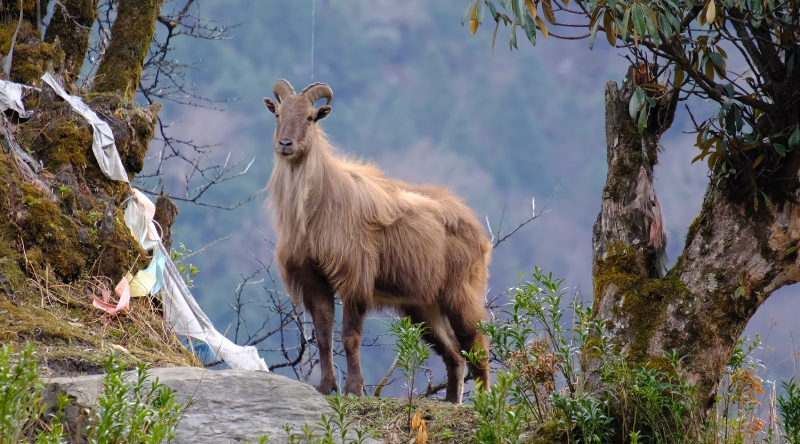
Himalayan Thar( Mountain Goat)
The Manaslu Circuit Trek offers trekkers the opportunity to experience a diverse range of wildlife and natural highlights along the trail. Here are some notable examples:
Himalayan Wildlife: Keep an eye out for elusive Himalayan wildlife such as the snow leopard, Himalayan tahr, blue sheep, musk deer, and Himalayan marmot. While sightings are rare, the chance to encounter these magnificent creatures adds excitement to the trek.
Bird Watching: The region is home to a variety of bird species, including the colorful Himalayan Monal, Nepal’s national bird. Other bird species you may spot include eagles, vultures, pheasants, and various songbirds.
Flora Diversity: Trek through diverse landscapes ranging from lush forests of rhododendron, pine, and oak trees to barren, high-altitude terrain. Marvel at the array of wildflowers blooming along the trail, including primroses, edelweiss, and Himalayan blue poppies.
Breathtaking Views: Enjoy panoramic vistas of snow-capped peaks, including the majestic Mt. Manaslu (8,163 meters), the eighth highest mountain in the world. Other prominent peaks visible along the trek include Himalchuli, Ngadi Chuli (Peak 29), Ganesh Himal, and Himlung Himal.
Glacial Lakes and Rivers: Encounter glacial lakes and pristine mountain streams as you traverse the rugged landscape. The Birendra Tal and Pung Gyen glaciers are among the natural wonders that add to the trek’s scenic beauty.
Waterfalls: Admire cascading waterfalls tumbling down steep cliffs, providing refreshing breaks and stunning photo opportunities. Notable waterfalls along the route include the Soti Khola Waterfall and the Bhote Koshi River.
Cultural Highlights: Experience the rich cultural heritage of the region by visiting traditional villages inhabited by ethnic groups such as the Gurungs, Tamangs, and Tibetans. Explore ancient monasteries, chortens (Buddhist stupas), and prayer flags that dot the landscape, offering insight into the local way of life.
Overall, the Manaslu Circuit Trek provides an immersive experience in nature, offering trekkers the chance to encounter diverse wildlife, stunning landscapes, and cultural treasures along the trail.
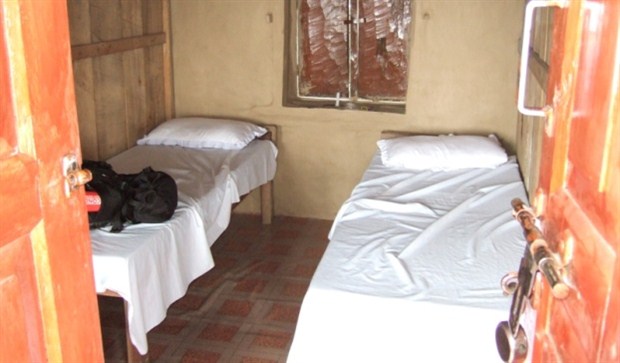
Tea House Accommodation
Accommodation options along the Manaslu Circuit Trek vary from basic teahouses to more comfortable lodges. Here’s an overview of the types of accommodations you can expect along the route:
Teahouses/Guesthouses: These are the most common form of accommodation along the trekking route. Teahouses offer basic amenities such as a bed with blankets, communal dining areas, and shared toilet facilities (often squat toilets). Meals are typically provided at the teahouse where you stay, offering a chance to enjoy local cuisine and interact with fellow trekkers.
Camping: For those seeking a more adventurous experience, camping is an option along the Manaslu Circuit Trek. However, camping requires bringing your own camping gear or hiring a trekking company that provides camping equipment and support staff such as cooks and porters. Camping allows for greater flexibility in itinerary and a more secluded experience in nature.
Homestays: In some villages, particularly in more remote areas, you may have the opportunity to stay with local families in homestays. This provides an authentic cultural experience and a chance to immerse yourself in the daily life of the villagers. Accommodations are usually basic but offer a warm and welcoming atmosphere.
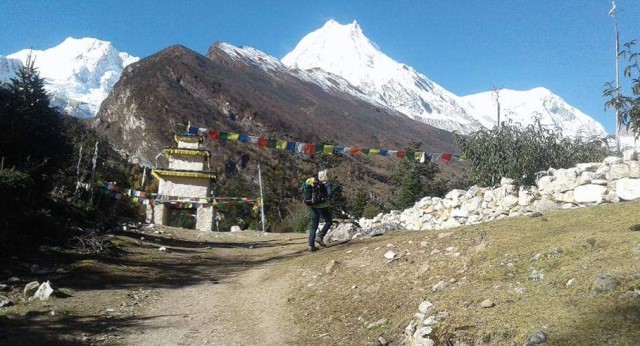
The best times to trek the Manaslu Circuit are during the spring (March to May) and autumn (September to November) seasons. Spring offers mild temperatures, blooming rhododendrons, and clear skies, making it ideal for trekking. Autumn brings stable weather conditions, crisp mountain views, and post-monsoon greenery. During these seasons, the weather is generally dry, with minimal risk of rainfall or snowfall, ensuring safe and enjoyable trekking conditions. However, trekkers should avoid the monsoon season (June to August) due to heavy rainfall and the winter months (December to February) when the trail may be impassable due to snow and cold temperatures.